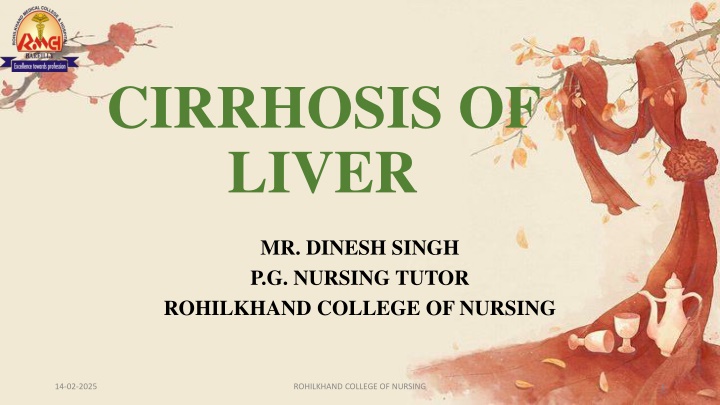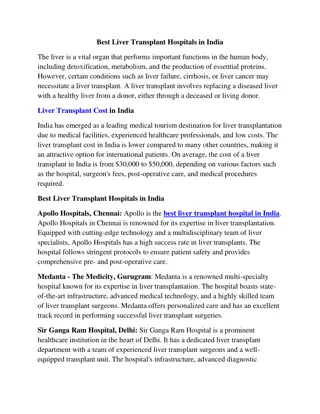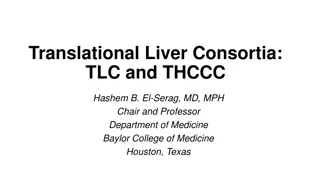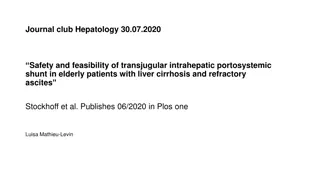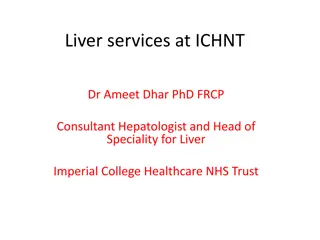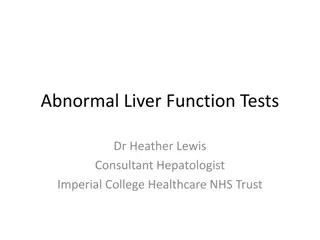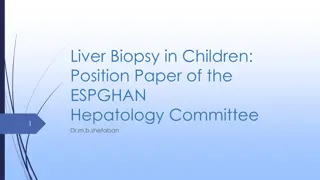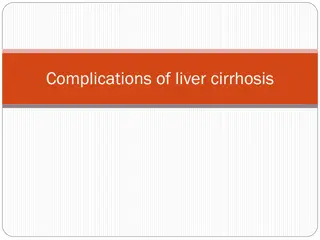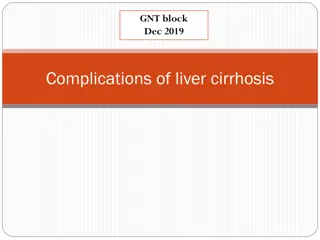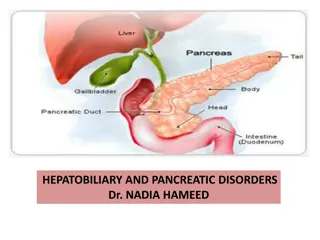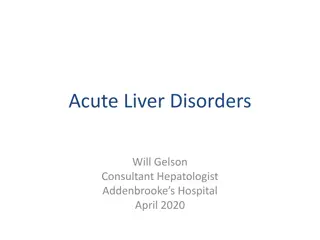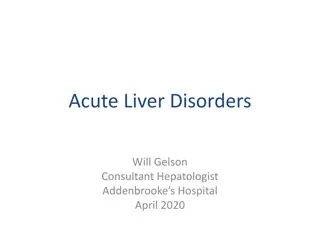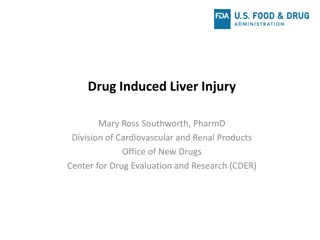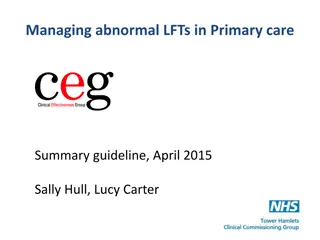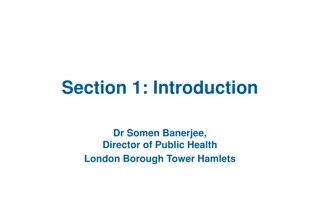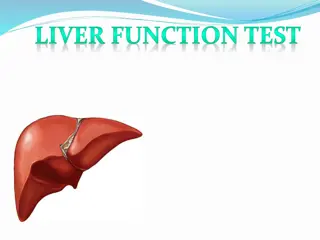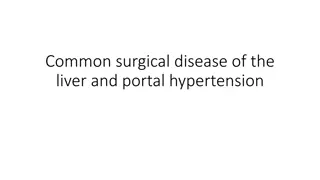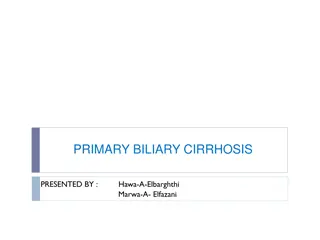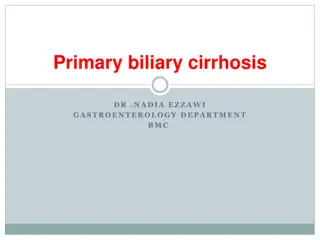CIRRHOSIS OF LIVER
Cirrhosis is a late-stage liver disease characterized by replacement of healthy liver tissue with scar tissue, leading to irreversible damage. Etiology includes alcoholism, hepatitis, biliary obstruction, and more. Learn about types and pathophysiology of cirrhosis.
Download Presentation

Please find below an Image/Link to download the presentation.
The content on the website is provided AS IS for your information and personal use only. It may not be sold, licensed, or shared on other websites without obtaining consent from the author.If you encounter any issues during the download, it is possible that the publisher has removed the file from their server.
You are allowed to download the files provided on this website for personal or commercial use, subject to the condition that they are used lawfully. All files are the property of their respective owners.
The content on the website is provided AS IS for your information and personal use only. It may not be sold, licensed, or shared on other websites without obtaining consent from the author.
E N D
Presentation Transcript
CIRRHOSIS OF LIVER MR. DINESH SINGH P.G. NURSING TUTOR ROHILKHAND COLLEGE OF NURSING 14-02-2025 ROHILKHAND COLLEGE OF NURSING 1
LOBES OF THE LIVER 14-02-2025 ROHILKHAND COLLEGE OF NURSING 2
SEGMENT OF THE LIVER 14-02-2025 ROHILKHAND COLLEGE OF NURSING 3
INTRODUCTION Cirrhosis is a late-stage liver disease in which healthy liver tissue is replaced with scar tissue and the liver is permanently damaged. 14-02-2025 ROHILKHAND COLLEGE OF NURSING 4
DEFINITION Cirrhosis complication of liver disease which involve loss of liver cells and irreversible scaring of liver cells. It is a chronic disease characterized by replacement or degenerative changes in normal liver cells. Tissue with diffuse fibrosis and nodules that disturbs the structure and function of liver. Also scar formation occurs due to destroyed hepatocytes. 14-02-2025 ROHILKHAND COLLEGE OF NURSING 5
14-02-2025 ROHILKHAND COLLEGE OF NURSING 6
ETIOLOGY Alcoholism Hepatitis A,B,C,D Hepatotoxic drugs CHF (Congestive heart failure) Biliary obstruction Diabetes Glycogen storage disease Immunological causes 14-02-2025 ROHILKHAND COLLEGE OF NURSING 7
TYPES 1. Post Necrotic Cirrhosis: Due to severe inflammation and massive necrosis of hepatocytes cells. 2. Alcoholic Cirrhosis: It occurs due to excessive intake of alcohol that leads to accumulation of fat in liver. 3. Biliary Cirrhosis: Due to biliary obstruction for long time and cholestasis (stoppage of growth) 4. Cardiac Cirrhosis: Main cause of this type of cirrhosis is right side congestive heart failure. 14-02-2025 ROHILKHAND COLLEGE OF NURSING 8
PATHOPHYSIOLOGY Due to Alcohol abuse, Malnutrition, Infection, Drugs or Biliary obstruction Destruction of hepatocytes Fibrosis/scar formation Obstruction of blood flow Increase pressure in venous and sinusoidal channels Fatty infiltration fibrosis/scaring Portal hypertension ROHILKHAND COLLEGE OF NURSING 14-02-2025 9
14-02-2025 ROHILKHAND COLLEGE OF NURSING 10
CLINICAL MANIFESTATION 2. If biliary obstruction 1. Early symptoms due to inflammation Increase serum bilirubin level so appear dark color of urine. Fever Jaundice due to accumulation of Pain bilirubin under skin. Anorexia Fatigue nausea 14-02-2025 ROHILKHAND COLLEGE OF NURSING 11
Conti 3. Hormonal disturbances 4. Other Symptoms are Reduce androgen and estrogen which Oedema produce abnormal menses Ascites (excess abdominal fluid) Amenorrhea Abdominal distension Loss of body hair Increased abdominal girth Gynecomastia (upper swelling on Yellowish skin breast in men) Difficulty in breathing 14-02-2025 ROHILKHAND COLLEGE OF NURSING 12
DIAGNOSTIC EVALUATION 1. Serum examination Increased SGOT/SGPT level: high level SGOT/SGPT released into the blood may be a sign of liver or heart damage. Low protein level Increase bilirubin level raised 2. Liver Function Test 3. AST-Aspirate Aminotransferase (Test is a blood test that checks for liver damage) 4. ALT- Alanine Transferase 14-02-2025 ROHILKHAND COLLEGE OF NURSING 13
Conti LDH- Lactate dehydrogenase Ultrasound ( for Hepatomegaly) WBC (for determination of infection) RBC (in Anaemia) Liver biopsy- FNAC (Fine Needle Aspiration Cytology) Abdominal paracentesis (for determine pus cells bacterial infection or protein component in accumulated fluid). 14-02-2025 ROHILKHAND COLLEGE OF NURSING 14
MANAGEMENT Antacids Antiemetics Vitamins and nutritional supplement Balanced diet Potassium sparing diuretics (for ascites), e.g. Spironolactone. Avoidance of alcohol. 14-02-2025 ROHILKHAND COLLEGE OF NURSING 15
SURGICAL MANAGEMENT 1. Porta-Caval Shunt (porta caval anastomosis) A Surgical technique in which hepatic portal vein is joined to inferior vena cava. 2. Splenorenal Shunt (splenorenal anastomosis) A surgical technique in which spleen vein is joined to the left renal vein. (mostly for treating portal hypertension). 3. Liver Transplant: Right lobe 60-70% of whole liver. Left lobe 30-40%. 14-02-2025 ROHILKHAND COLLEGE OF NURSING 16
DIETARY MANAGEMENT Provide high caloric diet and low liquid dirt (800-1000 ml/day) In Hepatic coma, give low protein and low sodium diet. Provide Albumin containing food. Vitamin A, D, E, K include with diet to patient. 14-02-2025 ROHILKHAND COLLEGE OF NURSING 17
REFERENCES 14-02-2025 ROHILKHAND COLLEGE OF NURSING 18
14-02-2025 ROHILKHAND COLLEGE OF NURSING 19
